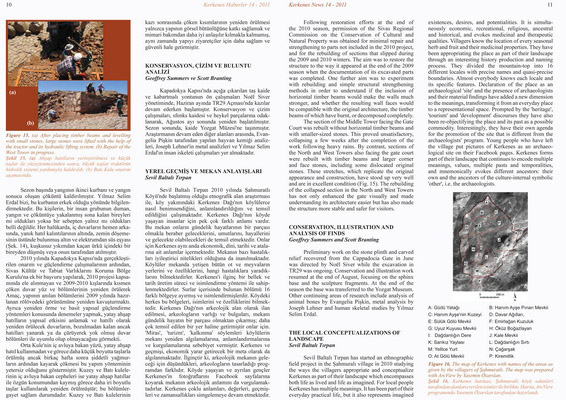| |
Following restoration efforts at the end of the 2010 season, permission of the Sivas Regional Commission on the Conservation of Cultural and Natural Property was obtained for minimal repair and strengthening to parts not included in the 2010 project, and for the rebuilding of sections that slipped during the 2009 and 2010 winters. The aim was to restore the structure to the way it appeared at the end of the 2009 season when the documentation of its excavated parts was completed. One further aim was to experiment with rebuilding and simple structural strengthening methods in order to understand if the inclusion of horizontal timber beams would make the walls much stronger, and whether the resulting wall faces would be compatible with the original architecture, the timber beams of which have burnt, or decomposed completely.
The section of the Middle Tower facing the Gate Court was rebuilt without horizontal timber beams and with smaller-sized stones. This proved unsatisfactory, collapsing a few weeks after the completion of the work following heavy rains. By contrast, sections of the North and West Towers also facing the gate court were rebuilt with timber beams and larger corner and face stones, including some dislocated original stones. These stretches, which replicate the original appearance and construction, have stood up very well and are in excellent condition (Fig. 15). The rebuilding of the collapsed section in the North and West Towers has not only enhanced the gate visually and made understanding its architecture easier but has also made the structure more stable and safer for visitors.
CONSERVATION, ILLUSTRATION AND
ANALYSIS OF FINDS
Geoffrey Summers and Scott Branting
Preliminary work on the stone plinth and carved relief recovered from the Cappadocia Gate in June was directed by Noël Siver while the excavation in TR29 was ongoing. Conservation and illustration work resumed at the end of August, focusing on the sphinx base and the sculpture fragments. At the end of the season the base was transferred to the Yozgat Museum. Other continuing areas of research include analysis of animal bones by Evangelia Pişkin, metal analysis by Joseph Lehner and human skeletal studies by Yılmaz Selim Erdal.
THE LOCAL CONCEPTUALIZATIONS OF
LANDSCAPE
Sevil Baltalı Tırpan
Sevil Baltalı Tırpan has started an ethnographic fi eld project in the Şahmuralı village in 2010 studying the ways the villagers appropriate and conceptualize Kerkenes as part of their landscape which encompasses both life as lived and life as imagined. For local people Kerkenes has multiple meanings. It has been part of their everyday practical life, but it also represents imagined existences, desires, and potentialities. It is simultaneously economic, recreational, religious, ancestral and historical, and evokes medicinal and therapeutic qualities. Villagers know the location of every seasonal herb and fruit and their medicinal properties. They have been appropriating the place as part of their landscape through an interesting history production and naming process. They divided the mountain-top into 16 different locales with precise names and quasi-precise boundaries. Almost everybody knows each locale and its specifi c features. Declaration of the place as an archaeological 'site' and the presence of archaeologists and their material fi ndings have added a new dimension to the meanings, transforming it from an everyday place to a representational space. Prompted by the 'heritage', 'tourism' and 'development' discourses they have also been re-objectifying the place and its past as a possible commodity. Interestingly, they have their own agenda for the promotion of the site that is different from the archaeologists' program. Young people who have left the village put pictures of Kerkenes as an archaeological site on their Facebook pages. Kerkenes forms part of their landscape that continues to encode multiple meanings, values, multiple pasts and temporalities, and mnemonically evokes different ancestors: their own and the ancestors of the culture-internal symbolic 'other', i.e. the archaeologists.
|



